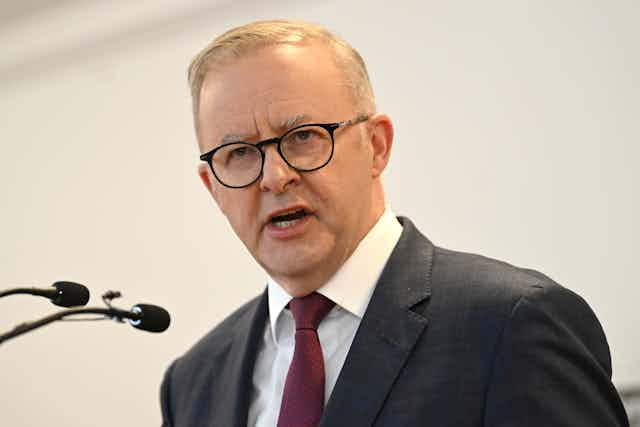A federal Newspoll, conducted March 1-4 from a sample of 1,530, gave Labor a 54-46 lead, a one-point gain for the Coalition since the previous Newspoll in early February. Primary votes were 37% Labor (down one), 35% Coalition (up one), 10% Greens (down one), 7% One Nation (up one) and 11% for all Others (steady).
While the Coalition only gained one point on two party vote, the change in primary votes implies that the Coalition’s gains were greater, and that rounding saved Labor from a 53-47 Newspoll.
Prime Minister Anthony Albanese’s ratings dropped, with 55% satisfied (down two) and 38% dissatisfied (up five), for a net approval of +17, down seven points. Since the December Newspoll, Albanese has lost 16 points of net approval.
Opposition Leader Peter Dutton’s net approval was down one point to -11. Albanese led Dutton as better PM by 54-28 (56-26 in February). Newspoll figures are from The Poll Bludger.
By 64-29, voters approved of the proposed changes to super that would increase the tax rate from 15% to 30% for account balances above $3 million.
I agree with this article by Peter Brent in Inside Story: Labor would have been better off implementing the super changes in July 2024, not July 2025. Implementing them in 2024 would give the changes time to get bedded down before the next election, and for voters to get used to them. The 2025 implementation date will give the Coalition an opportunity for a scare campaign at the next election.
There is precedent for governments’ polling improving once a major change has been implemented, and the sky hasn’t fallen in. As Brent says, this applied to both the introduction of the GST in July 2000 and to the introduction of the carbon tax in July 2012.
Labor and Albanese’s current slide in the polls is probably much more due to high inflation and interest rates than policy issues.
Federal Morgan poll: 56.5-43.5 to Labor
In last week’s federal Morgan poll, conducted February 20-26, Labor led by 56.5-43.5, a two-point gain for the Coalition since the previous week. Primary votes were 37% Labor, 34.5% Coalition, 13.5% Greens and 15% for all Others.
NSW Resolve poll: Labor increases large lead
The New South Wales state election will be held on March 25. A Resolve poll for The Sydney Morning Herald, conducted February 22-26 from a sample of 803, gave Labor 38% of the primary vote (up one since January), the Coalition 32% (down two), the Greens 11% (down one), independents 13% (up one) and others 7% (up two).
Resolve did not give a two party estimate for this poll, but analyst Kevin Bonham estimated 56-44 to Labor, a one-point gain for them since January.
Independent support is almost certainly being overstated by Resolve, and it is likely they will crash back to something more plausible in the final Resolve poll, which will be based on actual lists of candidates after nominations close on Wednesday. A slump for independents occurred in both Victoria and federally close to elections.
Liberal Premier Dominic Perrottet had a 38-34 lead as preferred premier over Labor leader Chris Minns (33-29 in January). By 45-40, voters thought Perrottet had performed well in recent weeks, while for Minns this was a 43-28 good performance.
Since the 2022 federal election, Resolve has generally been more favourable to Labor than other pollsters in both its federal and state polls. This poll is far better for Labor than the NSW Freshwater and Morgan polls below and the NSW Newspoll that I covered last Monday. All these polls were conducted at about the same time in late February.
Read more: Labor's lead reduced in a NSW Newspoll four weeks before election; Voice support steady
NSW Freshwater poll: 53-47 to Labor
The Poll Bludger reported that a NSW Freshwater poll for The Financial Review gave Labor a 53-47 lead, a one-point gain for the Coalition since last October’s Freshwater poll. Primary votes were 39% Labor (up two), 37% Coalition (up two), 10% Greens (down one), 5% independents (steady) and 9% others (down three).
Liberal Premier Dominic Perrottet led Labor leader Chris Minns by 46-34 as preferred premier, reversing a 41-38 lead for Minns in October. On issue salience, cost of living was way ahead of any other issue. This poll was conducted February 23-25 from a sample of 1,247.
A Freshwater seat poll, reported by Bonham, of the safe Liberal seat of Pittwater, also for The Financial Review, had the Liberals leading independent challenger Jacqui Scruby by a 52-48 margin. Primary votes were 41% Liberals, 30% Scruby, 16% Labor, 4% Greens and 9% others. Seat polls are unreliable.
NSW Morgan poll: 52.5-47.5 to Labor
A NSW Morgan SMS poll, conducted February 24-28 from a sample of 981, gave Labor a 52.5-47.5 lead. Primary votes were 33.5% Labor, 32.5% Coalition, 11% Greens, 8.5% One Nation, 3.5% “teal independents”, 3% Animal Justice and 8% others.
One Nation is unlikely to contest most lower house seats. In seats they don’t contest, their voters are likely to benefit the Coalition. Bonham said the Coalition would benefit on preferences from the absence of One Nation candidates as NSW uses optional preferential voting, so a primary vote for One Nation may exhaust, but not one for the Coalition.
In forced choice questions, Perrottet had a 53-47 approval rating, but Minns led as better premier by 54-46. This poll should not be compared with the NSW January Morgan poll as that used a different methodology.
Tasmanian EMRS poll: Liberals retain lead
A Tasmanian EMRS poll, conducted February 14-19 from a sample of 1,000, gave the Liberals 42% (steady since November), Labor 30% (up one), the Greens 13% (down one) and all Others 15% (down one). Liberal incumbent Jeremy Rockliff led Labor’s Rebecca White by 44-36 as preferred premier (46-34 in November).
Tasmania does not use a single-member system for its lower house elections, so a two party vote is not applicable.

